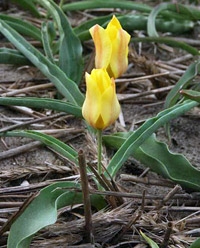Genome size of wild tulips determined
Leiden researcher Dr Ben Zonneveld has determined the size of the genome - the amount of DNA per nucleus - of wild tulips. His conclusion is that there are more than 87 wild species. Various possibly new species have been discovered.

The research has given a new perspective on the kinship of wild tulips to one another. Each tulip species has its own, often unique DNA weight. This is what makes it possible to classify wild tulips, that are often difficult to distinguish in terms of appearance. More than 400 wild tulips from Europe and Asia were collected for this research.
7 picograms for humans
The weight of DNA is expressed in picograms. A picogram is one-millionth of a millionth of a gram. The weight of the DNA per tulip nucleus seems to show strong variations: from 32 picograms for the Clusius tulip to 69 picograms for Tulipa gesneriana. Humans have approximately 7 picograms.
Zonneveld: ‘This says nothing about the number of genes, which is roughly the same for humans as for tulips. But tulips have a much greater amount of DNA that has no clear function. We don't yet understand why this is so, but it has partly to do with the size of the cell: the more DNA, the greater the nucleus, and the bigger the cell.'
Illegal trade
Zonneveld used a technique known as flow cytometry. Zonneveld: ‘This is not only an interesting and fast way of finding out something about the taxonomy, but also is also a check on the illegal trade in protected species.'
Kazakhstan
One of the species - shown here - discovered in the research has been described. It is the Tulipa lemmersii from the Mashad pass in Kazakhstan. It is named after Wim Lemmers, an eminent scholar of wild tulips.
Cultivated tulip not from Turkey
Where the cultivated tulip comes from and which species they originate from is not yet clear. Further research has to be carried out on this question. It is certain, however, that they do not in any event come from present-day Turkey, as legend would have it. Zonneveld: ‘Most wild tulips are found in Central Asia and not in Turkey.'
Clusius
The first tulips in the Netherlands blossomed in Leiden in 1594 in the Hortus botanicus, and were planted by Carolus Clusius. Zonneveld therefore considers it apt that an extensive study into the size of the genome of all wild tulip species has now taken place in Leiden. This started in the University, in the department of Molecular Plant Studies, and recently moved to the Leiden section of the National Herbarium of the Netherlands.
BJM Zonneveld (2009) The systematic value of nuclear genome size for all species of Tulipa L. (Liliacaeae). Plant Systematics and Evolution 281: 217-245.
